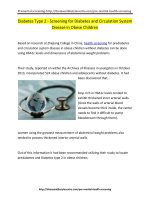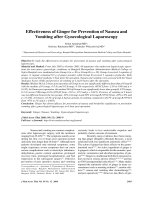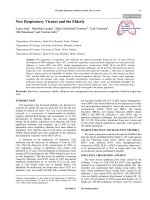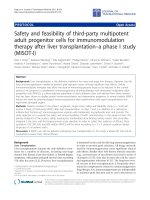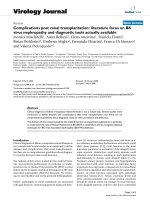New Onset Diabetes and Nephropathy after Renal Transplantation
Bạn đang xem bản rút gọn của tài liệu. Xem và tải ngay bản đầy đủ của tài liệu tại đây (84.83 KB, 9 trang )
Prevention of Diabetic Nephropathy
Lai KN, Tang SCW (eds): Diabetes and the Kidney.
Contrib Nephrol. Basel, Karger, 2011, vol 170, pp 247–255
New-Onset Diabetes and Nephropathy
after Renal Transplantation
Joelle Guitarda и Lionel Rostainga,b и Nassim Kamara,b
a
Department of Nephrology, Dialysis, and Organ Transplantation, CHU Rangueil, and
INSERM U563, IFR-BMT, CHU Purpan, Toulouse, France
b
Abstract
New-onset diabetes mellitus after transplantation (NODAT) is an important complication
after kidney transplantation, responsible for increased mortality mainly related to cardiovascular events and infections. It has been also identified as an independent risk factor associated with graft loss. The varying definitions of diabetes used in the literature,
and the prevalence and incidence of NODAT, are difficult to establish: it varies from 2 to
50% in the kidney transplant population. However, using the World Health Organization
and the American Diabetes Association criteria, it occurs in ~15% of transplant recipients
at 1 year in the USA, and ~5–10% in Europe. The main recipient-related risk factors
include old age, high body weight and high body mass index (BMI) before transplantation, Afro-American or Hispanic ethnicity, hepatitis C virus (HCV) infection, and impaired
fasting glucose level before transplantation. The other significant risk factors include
male donor, acute rejection episodes, cytomegalovirus (CMV) infection and the immunosuppressive regimen, especially the use of tacrolimus (FK506), steroids, or mammalian
target for rapamycin inhibitors. While some risk factors cannot be modified, others, such
as recipient body weight, BMI, HCV or CMV infection, and immunosuppressive regimen
can be controlled with an appropriate diet or treatment. Screening for impaired fasting
glucose should be done before transplantation in dialysis or end-stage renal disease
patients to identify patients at risk for NODAT. In patients with increased BMI, weight loss
before transplantation reduces the risk of NODAT. HCV infection should be treated before
transplantation. Prolonged anti-CMV prophylaxis may be used. Cyclosporine A is preferred to tacrolimus in patients at high risk of NODAT. A steroid-free regimen or early
steroid withdrawal is encouraged to reduce the risk of NODAT.
The introduction of novel immunosuppressive drugs has allowed a significant
decrease in the incidence of allograft rejection after renal transplantation.
Downloaded by:
UCSF Library & CKM
169.230.243.252 - 3/31/2015 9:57:08 AM
Copyright © 2011 S. Karger AG, Basel
Patient and graft survival rates, however, have not significantly improved [1],
partly because of the increased burden of posttransplant complications, including new-onset diabetes mellitus after transplantation (NODAT).
Harmful Effect of New-Onset Diabetes Mellitus after Renal Transplantation
Increased mortality has been reported in patients with NODAT compared to
patients without NODAT [2], mainly due to cardiovascular complications, but
also because of an increased incidence of infections. Compared to kidney transplant patients without NODAT, diabetic patients have a higher incidence and
greater severity of infections, which results in increased posttransplant mortality [2].
Cosio et al. [3] have shown that the 5-year cumulative incidence of cardiovascular events was correlated with fasting glucose level at 1 year after transplantation [3]. The incidence of cardiovascular events was significantly higher
in patients with diabetes or a moderately elevated fasting glucose level compared to those with a normal fasting glucose level at 1 year after transplantation. In addition, a multivariate analysis identified fasting glucose levels at 1,
4, and 12 months after transplantation, as independent predictive factors for
a cardiovascular event occurring after kidney transplantation [3]. In a prospective study, Ducloux et al. [4] had shown that NODAT is an independent
risk factor for the appearance of atheromatous disease in kidney transplant
patients (RR = 1.34, 95% CI 1.04–2.18). Pretransplantation diabetes is also a
predictive factor for all-cause and cardiovascular mortality after kidney transplantation [5].
NODAT also accounts for lower graft survival [2] and is an independent risk
factor associated with graft loss [6]. At 5 years, graft function, as defined by
serum creatinine level, is significantly lower in NODAT patients compared to
patients without NODAT [6]. Authentic biopsy-proven diabetic nephropathy
has been reported in patients who develop NODAT.
Moreover, classic complications of diabetes mellitus, such as ketoacidosis,
hyperosmotic diabetic coma, or peripheral neuropathy, have been described in
renal-allograft patients with NODAT [6]. NODAT also has an impact on the
quality of life of transplant patients and represents an important economic burden [7].
The varying definitions of diabetes used in the literature and the prevalence and
incidence of NODAT are difficult to establish.
248
Guitard · Rostaing · Kamar
Downloaded by:
UCSF Library & CKM
169.230.243.252 - 3/31/2015 9:57:08 AM
Prevalence and Incidence of New-Onset Diabetes Mellitus after Renal
Transplantation
According to the World Health Organization (WHO) and the American
Diabetes Association (ADA), diabetes is currently defined by the association of
diabetes symptoms (polyuria, polydipsia, weight loss) and a fasting glucose level
≥7 mm (1.26 g/dl), or a nonfasting glucose level of ≥11.1 mm (2 g/dl), or the use
of insulin and/or oral antidiabetic drugs. Impaired glucose tolerance is defined
by a fasting glucose level between 6.1 and 7 mm. Abnormal glucose levels must
be assessed twice to confirm diagnosis.
The prevalence and incidence of diabetes is higher in transplant patients
than in the general population, and is estimated to be between 2 and 50%
according to the literature [8]. NODAT usually occurs in the first 3 posttransplantation months [8]. Using the USRDS registry, Kasiske et al. [2] estimated the cumulative incidence of NODAT in patients who had received a
first renal allograft between 1996 and 2000. Patients were considered diabetic
if reported to the Medicare system. The cumulative incidences were 9.1, 16,
and 24% at 3, 12, and 36 months, respectively [2]. Using the WHO/ADA criteria for diabetes, Cosio et al. [3] reported a prevalence of impaired glucose
tolerance and NODAT in 33 and 13% of patients, respectively, at 1 year after
transplantation [3].
A French multicenter observational study that included 527 patients identified using WHO criteria reported a NODAT prevalence of 7%, with a median
time until NODAT onset of 1.6 months [9]. Impaired fasting glucose was found
in 7.9% of patients [9]. Diabetes is probably underestimated in the majority of
studies. For example, in 122 renal transplant patients in whom fasting glucose
levels were between 5.6 and 6.1 mm, and who had undergone an oral glucose
tolerance test (OGT), the occurrence of NODAT, impaired fasting glucose,
or high fasting glucose levels were diagnosed in 10, 14, and 18% of patients,
respectively [10].
Similarly, with the help of an OGT, Porrini et al. [11] reported a 33% incidence of impaired fasting glucose and a 20% incidence of NODAT in 154
nondiabetic renal transplant patients receiving a tacrolimus-based immunosuppressive regimen in the first year after kidney transplantation [11]. Conversely,
a normal fasting glucose level and a normal OGT at day 5 after transplantation
are independent protective factors against NODAT [12].
Numerous studies have identified risk factors associated with NODAT (table 1)
[13]. The main recipient-related risk factors include old age, high body weight
and high body mass index (BMI) before transplantation, Afro-American or
Hispanic ethnicity, hepatitis C virus (HCV) infection, and an impaired fasting
glucose level before transplantation. Weight gain during the first posttransplantation year does not seem to be associated with NODAT. The polymorphism
New-Onset Diabetes and Nephropathy after Renal Transplantation
249
Downloaded by:
UCSF Library & CKM
169.230.243.252 - 3/31/2015 9:57:08 AM
Risk Factors for New-Onset Diabetes Mellitus after Transplantation
Table 1. Main risk factors for new-onset diabetes mellitus after kidney transplantation
Recipients’ factors
–
–
–
–
–
–
–
–
–
–
–
–
older age
male gender (controversial)
family history of diabetes
weight at transplantation
high BMI before transplantation
maximum BMI before transplantation
Afro-American or Hispanic ethnicity
low educational status
HCV infection
fasting glucose level before transplantation
impaired fasting glucose level before transplantation
metabolic syndrome:
high triglyceride level
low high-density lipoprotein level
Transplantation factors
–
–
–
–
–
–
male donor
cadaveric donor (controversial)
number of HLA mismatches (controversial)
occurrence of at least one episode of acute rejection
CMV infection
immunosuppressive regimen:
use of tacrolimus
tacrolimus trough levels
steroid pulses
high steroid daily dosage
high cumulative dose of steroids
use of mTOR inhibitors
of the promoter region of interleukin-6, in the position 174(G→C), has been
associated not only with type 2 diabetes and insulin resistance, but also with
NODAT [14]. The rs7903146 polymorphism of transcription factor-7-like 2 was
also significantly associated with NODAT in a population of 1,229 kidney transplant patients (OR 1.55, p = 0.02, for the CT genotype, and OR 1.79, p = 0.04, for
the TT genotype) [15].
The other significant risk factors associated with transplantation are gender (male donors), acute rejection episodes, cytomegalovirus (CMV) infection, and the immunosuppressive regimen, especially the use of tacrolimus
(FK506), steroids, and mammalian target for rapamycin inhibitors. An induction therapy with basiliximab has been recently identified as a risk factor for
NODAT [16]. Basiliximab, a monoclonal antibody directed against the receptor of interleukin-2 (CD25), inhibits CD4+ CD25+ lymphocytes that include
250
Guitard · Rostaing · Kamar
Downloaded by:
UCSF Library & CKM
169.230.243.252 - 3/31/2015 9:57:08 AM
HLA = Human leukocyte antigen; mTOR = mammalian target for rapamycin.
regulatory CD25+ CD4+ FOXP3+ T cells. Apparently, these subpopulations play a role in the development of diabetes, in particular type 1 diabetes
[16]. Although there is no clear pathophysiological explanation, it has been
shown that albuminuria on day 5 after transplantation [12], and albuminuria at months 3 and 6 after transplantation [17], are associated with NODAT.
Adiponectin, an anti-inflammatory protein synthesized by adipocytes, reduces
insulin resistance and atheromatosis. Elevated adiponectin levels appear to
prevent NODAT [18].
Although some risk factors cannot be modified, others, such as recipient body weight and BMI, HCV or CMV infection, and the immunosuppressive regimen, could be controlled with an appropriate diet or modified
treatment.
Measures to Reduce New-Onset Diabetes Mellitus after Transplantation
Risk Factors?
Screening for Impaired Fasting Glucose before Transplantation
Screening for impaired fasting glucose should be done before transplantation
in dialysis or end-stage renal disease patients to identify patients at risk for
NODAT, in order to ensure meticulous posttransplantation surveillance of glycemic levels and to adapt the immunosuppressive regimen.
Treatment of HCV Infection before Transplantation
A meta-analysis has shown that the relative risk of NODAT is 3.97-fold greater
(CI 95%: 1.83–8.61) in HCV-positive renal transplant patients compared to
HCV-negative renal transplant patients [19]. In HCV-positive patients, NODAT
may occur more frequently in patients treated with tacrolimus compared to
those receiving cyclosporine A (CsA; 57.8 vs. 7.7%, p < 0.0001) [20]. However,
the mechanism by which HCV favors NODAT is not well established. HCV may
affect glucose metabolism by inducing hepatocyte necrosis. Moreover, a link
between HCV infection and insulin resistance has been established in vitro and
in vivo. Finally, HCV could induce dysregulation in the hepatocyte production
of cytokines and insulin receptors.
As treatment of HCV infection is contraindicated after kidney transplantation because of the high risk of interferon therapy-induced acute rejection, it is
recommended to treat all prospective HCV-positive, RNA-positive, renal transplantation candidates in order to achieve viral eradication before transplantation [21].
New-Onset Diabetes and Nephropathy after Renal Transplantation
251
Downloaded by:
UCSF Library & CKM
169.230.243.252 - 3/31/2015 9:57:08 AM
Reducing Excess Weight before Transplantation
In patients with increased BMI, weight loss before transplantation reduces the
risk of NODAT, cardiovascular events, and postoperative complications.
Selection of Immunosuppressive Regimen
Calcineurin Inhibitors
Tacrolimus seems more prone to induce NODAT than CsA. In a meta-analysis
that evaluated the effect of different calcineurin inhibitors (CNIs) on the incidence of NODAT, Heisel et al. [22] found a higher incidence of NODAT in
patients receiving FK506 than patients receiving CsA (9.8 vs. 2.7%, RR = 3.7,
CI 95%: 2.6–15.36, p < 0.0001). The DIRECT Study is an international multicenter randomized study that compared the incidence of NODAT in de novo
renal transplant recipients who received either CsA or FK506 [23]. Amongst
the nondiabetic patients before transplantation, the incidence of NODAT at
6 months after transplantation was 26% in the CsA arm and 33.6% in the
FK506 arm (p = 0.0046). At 6 months, 8.9% of patients receiving CsA and
16.8% of patients receiving FK506 had received treatment for diabetes (p =
0.005) [23].
The economic impact of immunosuppressive regimen-induced diabetes was
evaluated to be USD 2,025 and USD 3,308 per patient receiving tacrolimus at 1
and 2 years after transplantation, respectively, while similar figures for patients
receiving CsA were only USD 1,137 and USD 1,611, respectively [7].
Both CsA and FK506 induce diabetes by reducing insulin secretion and
also, to a lesser extent, by inducing insulin resistance [24]. Insulin resistance
is increased by concomitant administration of steroids [24]. Asberg et al. [25]
have shown that, at 1 year after transplantation, insulin sensitivity was significantly improved in patients who had never received CNIs compared to patients
treated with CNIs. The different tissue localizations of the molecular targets of
CsA and FK506 could account for the greater impact of FK506 on NODAT.
Indeed, FKBP12, the target of FK506, is highly expressed in β-cells in the islets
of Langerhans, whereas CsAs, which target cyclophilin, is mostly expressed in
the heart, liver, and kidney.
Conversion from tacrolimus to cyclosporine in patients with NODAT
significantly improves fasting glucose levels and glycated hemoglobin compared
to patients maintained on tacrolimus [26]. At 1-year after conversion, remission
of NODAT, as defined by fasting glucose levels <1.26 g/l without any antidiabetic
treatment, was observed in 42% of converted patients versus 0% of patients
maintained on tacrolimus (p = 0.001) [26]. The concomitant interruption of
steroids also increases the advantage of conversion. Conversely, Luan et al. [27]
recently showed that a switch from CsA to FK506 at 11.4 months (range: 0.3–
83.8) after transplantation in 171 patients did not increase the incidence of
NODAT or impaired glucose tolerance when compared to 533 patients maintained on CsA, during a mean follow-up time of 31.5 ± 21.6 months.
252
Guitard · Rostaing · Kamar
Downloaded by:
UCSF Library & CKM
169.230.243.252 - 3/31/2015 9:57:08 AM
Reducing the Risk of Cytomegalovirus Infection
The risk of CMV primary infection or reactivation can be reduced by extended
prophylaxis of CMV infection in patients at risk for NODAT.
Steroid Avoidance or Steroid Reduction
Cumulative dose and daily steroid dosages are associated with an increased
incidence of NODAT [13], essentially through enhanced insulin resistance.
Immunosuppressive regimens based on steroid minimization have shown a
lower incidence of NODAT. At 6 months after transplantation, the incidence of
NODAT was 0.4% in patients receiving a steroid-free immunosuppressive regimen compared to 5.4% in patients receiving steroids [28]. Steroid withdrawal
within the first week after transplantation significantly reduced the incidence
of NODAT at 1 year compared to patients who were continued on steroids [29]
or compared to patients in whom steroids were withdrawn between 3 and 6
months after transplantation [1]. Conversely, comparison study of early steroid
withdrawal by day 7 versus continuation of low-dose steroids in de novo renal
transplant patients did not reveal any significant difference in the incidence of
NODAT at 5 years after transplantation [30]. However, the number of patients
developing NODAT that required insulin therapy was significantly lower in
the group of patients with early steroid withdrawal compared to the ‘low dose’
group [30]. Finally, a recent meta-analysis has shown that steroid withdrawal
between 3 and 6 months after transplantation does not reduce the incidence
of NODAT [1]. Thus, only a steroid-free regimen or early steroid withdrawal
reduces the incidence of diabetes.
Conclusion
The incidence of de novo diabetes after renal transplantation is higher than that
in the general population, and accounts for a decrease in patient and graft survival rate. Among the identified risk factors, some can be controlled in order to
reduce the incidence of NODAT.
1 Pascual J, Galeano C, Royuela A, Zamora J:
A systematic review on steroid withdrawal
between 3 and 6 months after kidney transplantation. Transplantation 2010;90:343–349.
2 Kasiske BL, Snyder JJ, Gilbertson D, Matas
AJ: Diabetes mellitus after kidney transplantation in the United States. Am J Transplant
2003;3:178–185.
3 Cosio FG, Kudva Y, van der Velde M, Larson
TS, Textor SC, Griffin MD, Stegall MD: New
onset hyperglycemia and diabetes are associated with increased cardiovascular risk after
kidney transplantation. Kidney Int 2005;
67:2415–2421.
4 Ducloux D, Kazory A, Chalopin JM:
Posttransplant diabetes mellitus and atherosclerotic events in renal transplant recipients:
a prospective study. Transplantation 2005;79:
438–443.
5 Kuo HT, Sampaio MS, Vincenti F,
Bunnapradist S: Associations of pretransplant diabetes mellitus, new-onset diabetes after transplant, and acute rejection
with transplant outcomes: an analysis of
the Organ Procurement and Transplant
Network/United Network for Organ Sharing
(OPTN/UNOS) database. Am J Kidney Dis
2010;56:1127–1139.
New-Onset Diabetes and Nephropathy after Renal Transplantation
253
Downloaded by:
UCSF Library & CKM
169.230.243.252 - 3/31/2015 9:57:08 AM
References
254
14 Bamoulid J, Courivaud C, Deschamps
M, Mercier P, Ferrand C, Penfornis A,
Tiberghien P, Chalopin JM, Saas P, Ducloux
D: IL-6 promoter polymorphism –174 is
associated with new-onset diabetes after
transplantation. J Am Soc Nephrol 2006;17:
2333–2340.
15 Ghisdal L, Baron C, Le Meur Y, Lionet A,
Halimi JM, Rerolle JP, Glowacki F, Lebranchu
Y, Drouet M, Noel C, El Housni H, Cochaux
P, Wissing KM, Abramowicz D, Abramowicz
M: TCF7L2 polymorphism associates with
new-onset diabetes after transplantation.
J Am Soc Nephrol 2009;20:2459–2467.
16 Aasebo W, Midtvedt K, Gretland Valderhaug
T, Leivestad T, Hartmann A, Varberg
Reisaeter A, Jenssen T, Holdaas H: Impaired
glucose homeostasis in renal transplant
recipients receiving basiliximab. Nephrol
Dial Transplant 2010:25:1289–1293.
17 Roland M, Gatault P, Al-Najjar A, Doute C,
Barbet C, Chatelet V, Laouad I, Marliere JF,
Nivet H, Buchler M, Lebranchu Y, Halimi
JM: Early pulse pressure and low-grade
proteinuria as independent long-term risk
factors for new-onset diabetes mellitus after
kidney transplantation. Am J Transplant
2008;8:1719–1728.
18 Bayes B, Granada ML, Pastor MC, Lauzurica
R, Salinas I, Sanmarti A, Espinal A, Serra
A, Navarro M, Bonal J, Romero R: Obesity,
adiponectin and inflammation as predictors
of new-onset diabetes mellitus after kidney
transplantation. Am J Transplant 2007;7:
416–422.
19 Fabrizi F, Martin P, Dixit V, Bunnapradist
S, Kanwal F, Dulai G: Post-transplant
diabetes mellitus and HCV seropositive
status after renal transplantation: metaanalysis of clinical studies. Am J Transplant
2005;5:2433–2440.
20 Bloom RD, Rao V, Weng F, Grossman RA,
Cohen D, Mange KC: Association of hepatitis C with posttransplant diabetes in renal
transplant patients on tacrolimus. J Am Soc
Nephrol 2002;13:1374–1380.
21 Kidney Disease: Improving Global
Outcomes (KDIGO): Prevention, diagnosis, evaluation and treatment of hepatitis
C in chronic kidney disease. Kidney Int
2008;72(suppl 109):S1–S99.
Guitard · Rostaing · Kamar
Downloaded by:
UCSF Library & CKM
169.230.243.252 - 3/31/2015 9:57:08 AM
6 Miles AM, Sumrani N, Horowitz R, Homel P,
Maursky V, Markell MS, Distant DA, Hong
JH, Sommer BG, Friedman EA: Diabetes
mellitus after renal transplantation: as deleterious as non-transplant-associated diabetes?
Transplantation 1998;65:380–384.
7 Woodward RS, Schnitzler MA, Baty J, Lowell
JA, Lopez-Rocafort L, Haider S, Woodworth
TG, Brennan DC: Incidence and cost of new
onset diabetes mellitus among U.S. waitlisted and transplanted renal allograft recipients. Am J Transplant 2003;3:590–598.
8 Montori VM, Basu A, Erwin PJ, Velosa JA,
Gabriel SE, Kudva YC: Posttransplantation
diabetes: a systematic review of the literature.
Diabetes Care 2002;25:583–592.
9 Kamar N, Mariat C, Delahousse M, Dantal
J, Al Najjar A, Cassuto E, Lefrancois N,
Cointault O, Touchard G, Villemain F, Di
Giambattista F, Benhamou PY: Diabetes mellitus after kidney transplantation: a French
multicentre observational study. Nephrol
Dial Transplant 2007;22:1986–1993.
10 Sharif A, Moore RH, Baboolal K: The use
of oral glucose tolerance tests to risk stratify
for new-onset diabetes after transplantation: an underdiagnosed phenomenon.
Transplantation 2006;82:1667–1672.
11 Porrini E, Moreno JM, Osuna A, Benitez R,
Lampreabe I, Diaz JM, Silva I, Dominguez R,
Gonzalez-Cotorruelo J, Bayes B, Lauzurica R,
Ibernon M, Moreso F, Delgado P, Torres A:
Prediabetes in patients receiving tacrolimus
in the first year after kidney transplantation: a prospective and multicenter study.
Transplantation 2008;85:1133–1138.
12 Kuypers DR, Claes K, Bammens B,
Evenepoel P, Vanrenterghem Y: Early clinical
assessment of glucose metabolism in renal
allograft recipients: diagnosis and prediction
of post-transplant diabetes mellitus (PTDM).
Nephrol Dial Transplant 2008;23:2033–2042.
13 Rodrigo E, Fernandez-Fresnedo G, Valero
R, Ruiz JC, Pinera C, Palomar R, GonzalezCotorruelo J, Gomez-Alamillo C, Arias M:
New-onset diabetes after kidney transplantation: risk factors. J Am Soc Nephrol 2006;
17:S291–S295.
27 Luan FL, Zhang H, Schaubel DE, Miles CD,
Cibrik D, Norman S, Ojo AO: Comparative
risk of impaired glucose metabolism
associated with cyclosporine versus
tacrolimus in the late posttransplant period.
Am J Transplant 2008;8:1871–1877.
28 Rostaing L, Cantarovich D, Mourad G,
Budde K, Rigotti P, Mariat C, Margreiter
R, Capdevilla L, Lang P, Vialtel P, OrtunoMirete J, Charpentier B, Legendre C,
Sanchez-Plumed J, Oppenheimer F, Kessler
M: Corticosteroid-free immunosuppression
with tacrolimus, mycophenolate mofetil, and
daclizumab induction in renal transplantation. Transplantation 2005;79:807–814.
29 Walczak D, Calvert D, Oberholzer J, Testa G,
Sankary H, Benedetti E: Effect of race on the
occurrence of posttransplant diabetes in kidney transplant recipients treated with early
steroid discontinuation. Transplant Proc
2005;37:819–821.
30 Woodle ES, First MR, Pirsch J, Shihab F,
Gaber AO, Van Veldhuisen P: A prospective, randomized, double-blind, placebocontrolled multicenter trial comparing early
(7 day) corticosteroid cessation versus longterm, low-dose corticosteroid therapy. Ann
Surg 2008;248:564–577.
Nassim Kamar, MD, PhD
Department of Nephrology, Dialysis, and Organ Transplantation
CHU Rangueil, TSA 50032
FR–31059 Toulouse Cedex 9 (France)
Tel. +33 5 61 32 23 35, Fax +33 5 61 32 39 89, E-Mail
New-Onset Diabetes and Nephropathy after Renal Transplantation
255
Downloaded by:
UCSF Library & CKM
169.230.243.252 - 3/31/2015 9:57:08 AM
22 Heisel O, Heisel R, Balshaw R, Keown P:
New onset diabetes mellitus in patients
receiving calcineurin inhibitors: a systematic
review and meta-analysis. Am J Transplant
2004;4:583–595.
23 Vincenti F, Friman S, Scheuermann E,
Rostaing L, Jenssen T, Campistol JM, Uchida
K, Pescovitz MD, Marchetti P, Tuncer
M, Citterio F, Wiecek A, Chadban S, ElShahawy M, Budde K, Goto N: Results of an
international, randomized trial comparing
glucose metabolism disorders and outcome with cyclosporine versus tacrolimus.
Am J Transplant 2007;7:1506–1514.
24 van Hooff JP, Christiaans MH, van
Duijnhoven EM: Tacrolimus and posttransplant diabetes mellitus in renal transplantation. Transplantation 2005;79:1465–1469.
25 Asberg A, Midtvedt K, Voytovich MH, Line
PD, Narverud J, Reisaeter AV, Morkrid
L, Jenssen T, Hartmann A: Calcineurin
inhibitor effects on glucose metabolism and
endothelial function following renal transplantation. Clin Transplant 2009;23:511–518.
26 Ghisdal L, Bouchta NB, Broeders N, Crenier
L, Hoang AD, Abramowicz D, Wissing KM:
Conversion from tacrolimus to cyclosporine
A for new-onset diabetes after transplantation: a single-centre experience in renal
transplanted patients and review of the literature. Transpl Int 2008;21:146–151.
